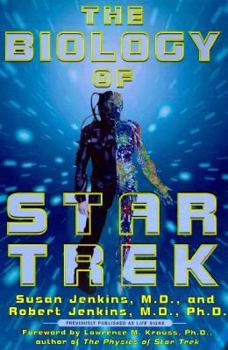The Biology of Star Trek
Select Format
Select Condition 
Book Overview
Could aliens have green blood? Why so Ferengis have such big ears? Is Commander Data really alive? What Star Trek fan hasn't pondered such weighty questions as these? Now, two noted scientists provide all the answers as they explore the sometimes fanciful, always fascinating, biological issues raised by Star Trek's various incarnations. Entertaining, insightful, and authoritative, The Biology of Star Trek will heighten your appreciation for the mind-expanding...
Format:Paperback
Language:English
ISBN:0060929243
ISBN13:9780060929244
Release Date:January 1999
Publisher:Harper Perennial
Length:208 Pages
Weight:0.39 lbs.
Dimensions:0.5" x 5.3" x 8.0"
Customer Reviews
5 ratings
Science + Star Trek = Fun
Published by Thriftbooks.com User , 16 years ago
A wonderful book, very readable, offering the insight of two scientists who explain the hows and whys of the biology of Star Trek. They do live up to "The Physics of Star Trek" and express how all this is possible, and gently point out where it isn't (i.e. if your space suit ruptured in open space, you'd probably be crushed by the vacuum, so Worf wouldn't have time to repair his suit with some handy Borg tubing). Regards to the Publisher's Weekly tease ("Why do all planets look like California?"), the authors actually say that the show was filmed in Souther California, hence, it was only able to offer some traditional Earth plant-life, whereas the real galaxy will have plants we cannot even fathom right now. Bush-Cheney '04.
Much Better
Published by Thriftbooks.com User , 17 years ago
If you read To Seek Out New Life, I'm sorry. There Andreadis claims to love Star Trek, and spends most of the book proving how false the science of the show is. She forgets the cardinal rule of a Trekkie- apologize for the show. Yes, it has problems in physics. Yes, there are continuity errors. Yes, the biology isn't always up to snuff. But you love the show, so you try to make it work. You try to find a work-around. And then, if you absolutely can't, you admit there was a mistake. This is the tradition the Jenkinses boldly go with. They use Star Trek to have fun with biology, and understand more about new life. What would Horta psychology be like? Why do Gorgons make us uncomfortable? Where do we find Trill-like species here on Earth? The Jenkinses use Trek to help us understand more about life, in the process fully explaining the biology, but not in such detail to bore the unscientific reader. This is what was great about the show. It entertained, yes, but it took us beyond. It made us struggle with philosophy, history, anthropology, and science. It made us think about new possibilities, and use our imaginations to understand the world around us. It is in this tradition that the Jenkinses lead us.
A fun read.
Published by Thriftbooks.com User , 24 years ago
I like Star Trek, I just am not a fanatic. As such, I hesitated in buying this book. Why should I care if, for example a Klingon and a Vulcan could or would want to mate? They don't exist! Still, after I read the back and skimmed through the chapters, I decided to buy it. It was great fun!First, this book is based on real science. The writers are well educated. In fact, they are both doctors and they explain real biology in an interesting way that makes it more interesting and accessible to the public. Teachers take note. But, this book is much more then a teaching tool. The writers are obvious fans of Star Trek and both have a delightful sense of humor. I found myself laughing outloud and sharing some of the stories with my friends. But it is hard for me to describe their humor, with taking away the hard scient. I think the fairest thing to do, is just tell you the title of some of the chapters. -What the future May hold, but Probably won't -Parasitic Possession is Nine-tenths of the Law or -Where No One Will Ever GoThese chapters are about the probablities of telepathy, real example of parasites on Earth, (and why they are unlikely in space) and examples of big bloopers in Captain Kirk's Universe. Why and what made the Klingons evolve, for example.Utimately this book is a tribute to Star Trek's attempts to potray science fiction in an accurate and truthful way. Science often inspires science fiction. It is Star Trek's great glory that a science fiction series has inspired this, and other works of science and scientist. Enjoy the Book.
Interesting insights
Published by Thriftbooks.com User , 24 years ago
This books answers some of the basic questions that Trekers have been asking for ages:Why do the old Klingons look different from the new Klingons? Could an alien really take over and control a human body? Can ageing be sped up, stopped or reversed?A really good read with just the right amount of depth. Recommended.
Thinking about getting this book? Make it so!
Published by Thriftbooks.com User , 26 years ago
This latest entry in the "Science of Star Trek" series examines several important concepts in the field of biology, with an emphasis on genetics. While including many references to various Star Trek episodes, the book's primary mission is to educate the reader, particularly in regard to cutting-edge research and theories. The authors do a great job in presenting this information in a manner that is easily understood, and all Trek fans will be delighted that many glaring "bloopers" (such as, why do so many aliens look so similar to humans? And what exactly happened to the Klingons?) are thoughtfully addressed. In short, this book is a worthy addition to a Star Trek fan's library.






